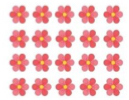General Information
Benchmark Instructional Guide
Connecting Benchmarks/Horizontal Alignment
Terms from the K-12 Glossary
- Cardinality Principle
- Whole Number
Vertical Alignment
Previous Benchmarks
Next Benchmarks
Purpose and Instructional Strategies
The purpose of this benchmark is to help students further develop the concept that counting gives the number of objects in a set and to reinforce the counting sequence. Students should count out a given number of objects, and if the counted set is rearranged or moved, students should restate the number of objects without counting.- Instruction includes the use of manipulatives and pictorial representations.
- Instruction may use ten-frames or similar organizers to help students organize their counting (MTR.5.1).
- Instruction includes context to provide a purpose for counting (MTR.7.1).
Common Misconceptions or Errors
- Students may skip or repeat numbers when counting out objects.
- For example, a student may say "14, 15, 17."
- Students may lose track of which objects have been counted.
Strategies to Support Tiered Instruction
- Instruction includes modeling of a given target number to produce a set of objects beginning with quantities 0-5. The container holding the objects should contain a quantity greater than the target number so that students can demonstrate producing an exact set without going over the target number. Students must be able to identify the target number, what quantity that number represents, and where the target number is in relation to other numbers.
- Examples may include the following statements and questions to elicit student understanding:
- “What number is this?”
- “When you are counting, how will you know when to stop?”
- “Can you show me how many counters make this number?”
- “How can you keep track of how many you counted?”
- Examples may include the following statements and questions to elicit student understanding:
- Instruction includes presenting students with number cards to 5 for matching quantities of counters to each number card.
- Example:

- Teacher includes tasks for students exploring various containers to find which one contains the quantity of the target number card and match the remaining cards to their containers. Use five or ten frames to keep track of each quantity being counted.
- Example:

Instructional Tasks
Instructional Task 1
Students can work together in a teacher center, or this task could be completed in a center independently. Students are given various objects to count (counters, bears, beans, paperclips, etc.), and bags labeled with various numbers 1-20. Choosing from the objects, students will count out the number and place each set in the bag. The teacher can scaffold by pairing students or strategically assigning certain numbers to students.Instructional Task 2
There are five people sitting around a table. Everyone at the table needs to have one piece of paper and you want to make sure each person gets one. From a pack of paper, count out enough sheets to make sure everyone gets one.
Instructional Items
Instructional Item 1
Count out and circle 15 flowers.
